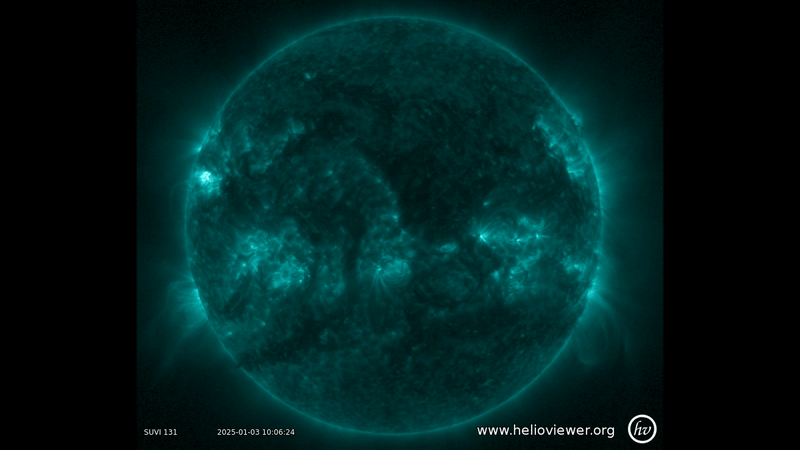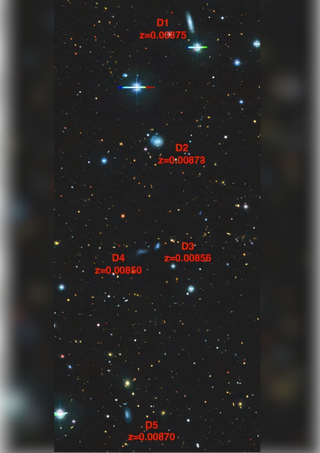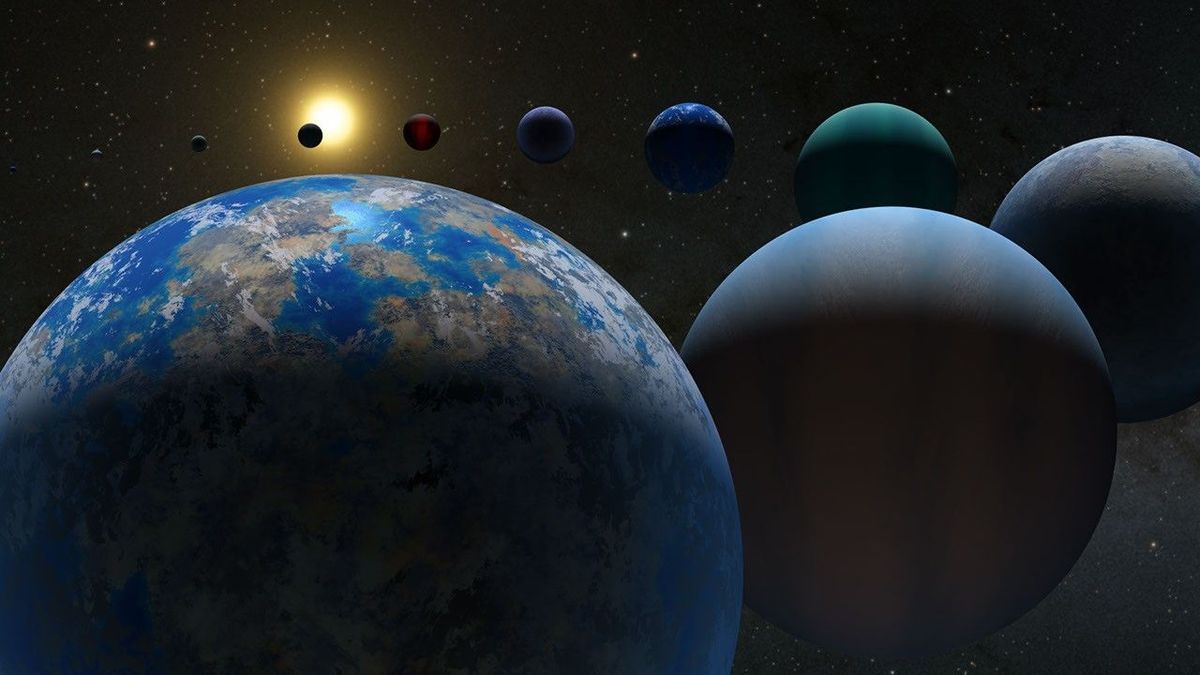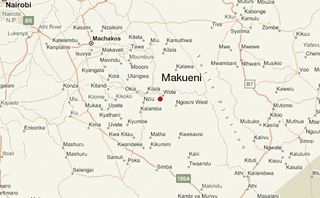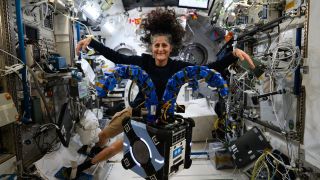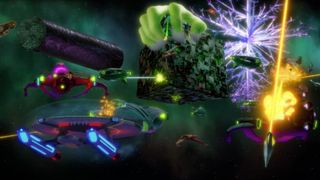On York Boulevard in Los Angeles, a blurred black hole hangs on a dark wall, joined only by a pair of headphones playing looping echoes of its siblings colliding. It’s a familiar scene of our galaxy’s supermassive central void, and certainly one that has flown far and wide over the years. I’d bet you’ve seen it. Journalists (including myself) have fawned over this image, affixing it to exhilarating news stories under titles like “First Image of Milky Way’s Black Hole” or “Center of Our Galaxy Revealed.” Universities have thrown it…
Read MoreCategory: Solar System
Our solar system
Sun erupts with powerful X1.2 solar flare, causes radio blackouts (photo)
The sun started 2025 with a bang as it fired off a powerful solar flare this morning. The X-class solar flare peaked at an X.12 at 6:40 a.m. EST (1140 GMT) on Friday (Jan. 3), releasing a blast of energy from a sunspot region known as AR 3947 and triggering a radio blackout event for parts of the Southern Atlantic, Africa and parts of eastern South America. When these blackouts happen, they can result in a full or partial loss of high frequency (HF) radio signals in regions that are…
Read MoreHow to watch SpaceX launch its 1st Falcon 9 rocket of 2025 tonight
SpaceX will launch its first Falcon 9 rocket of 2025 today, if all goes according to plan. A SpaceX Falcon 9 rocket is set to take off on Friday (Jan. 3) at 8:27 p.m. EST (0127 GMT) from Space Launch Complex 40 at Cape Canaveral Space Force Station in Florida. The flight will launch the Thuraya 4 spacecraft to geosynchronous orbit on behalf of Space42, a satellite and space services company based in the United Arab Emirates. The satellite will provide mobile communications services throughout Europe, the Middle East and…
Read MoreRare string of ‘cosmic pearls’ dance together in the universe
Astronomers have discovered a rare group of five dwarf galaxies located relatively close to Earth; these galaxies exist in a near-perfect alignment, resembling a string of cosmic pearls in the sky. Held together by their mutual gravity, several of the dwarf galaxies (designated D1 to D5) are rhythmically dancing with one another while others are engaged in a “cosmic tug of war,” ripping gas and stars away from each other. The scientists behind this discovery say these factors make this dwarf galaxy grouping particularly intriguing. The arrangement may be as…
Read MoreStrap on a VR headset like a Facehugger with ‘Alien: Rogue Incursion’ — the 1st-ever ‘Alien’ VR game
With the rush and the whirl of the holidays, it might have been easy to miss an invasion of the bold new VR video game, “Alien: Rogue Incursion.” Arriving on Dec. 19, 2024 from Survios in cooperation with 20th Century Games, this tactical sci-fi survival release for PlayStation VR2, PCVR via Steam, and Meta Quest 3 (Feb. 13, 2025) and was highly anticipated as an enveloping “Alien: Isolation“-type adventure all wrapped up nicely in a next-generation virtual reality environment. Critical reviews have been mixed, but mostly positive. But since this…
Read MoreNewly uncovered oxygen reaction could aid the search for alien life
Scientists have discovered a new way oxygen can form in carbon-dioxide-rich atmospheres of worlds beyond our own —- challenging assumptions about how we should search for life on other planets, and possibly about the origins of life itself. “Most of the search for life, or life signatures, on other planets is actually proving that whatever we observe can be generated through means that do not require life,” David Benoit, a senior lecturer in Molecular Physics and Astrochemistry at the University of Hull’s E.A. Milne Centre for Astrophysics who was not…
Read MoreSpace debris crash in Kenya village believed to be from leftover rocket hardware
Kenya Space Agency (KSA) officials in Nairobia, Kenya, East Africa, are reporting that on Dec. 30 a large metallic ring roughly 8 feet (2.5 meters) in diameter and weighing some 1,100 pounds (500 kilograms) fell from the sky, reportedly “red-hot” and crashed into Mukuku village, in Makueni county – in the country’s south. Investigators think the object is space debris, believed to be rocket leftovers that came crashing down, reportedly within the village at roughly 3 p.m. local time. The KSA “secured the area and retrieved the debris, which is…
Read MorePanasonic Leica Summilux DG 15mm f/1.7 ASPH review
Key specs Type: Prime lens Focal length: 15mm (30mm equivalent) Maximum aperture: f/1.7 Lens mount: Micro Four Thirds Weight: 4.06 oz / 115 g Dimensions: 1.42×2.26 in / 36×57.5 mm Filter thread: 46mm Release date: March 2014 In the fast-paced world of photography where new kit is constantly released, you may wonder where a 10-year-old lens fits into the equation. The Panasonic Leica Summilux DG 15mm f/1.7 ASPH remains a fantastic prime lens for Micro Four Thirds (MFT) cameras thanks to its compact size, light weight, and solid overall performance.…
Read MoreImage of the Day 2024 Archive
Space can be a wondrous place, and we’ve got the pictures to prove it! Take a look at our favorite space pictures here, and if you’re wondering what happened to today in space history don’t miss our On This Day in Space video show here! Suni beaming with an Astrobee (Image credit: NASA) Wednesday, December 18, 2024: What could be better than NASA astronaut Suni Williams floating aboard the International Space Station with Bumble, the blue, bunny-eared Astrobee. Bumble is one of three cube-shaped robo-helpers developed by NASA to assist…
Read More‘Star Trek: Lower Decks’: the 25 best ‘Trek’ callbacks from the show’s five-year mission
It’s a wrap. Or should that be a warp? The final episode of Star Trek: Lower Decks has aired and with it, the USS Cerritos’s five-year mission to explore strange corners of canon, to seek out new gags and comedic situations, to boldly go where no “Star Trek” has gone before has come to an end. So, in honor of the voyages of Starfleet’s second contact specialists, we’ve picked out 25 of the best ‘Trek’ callbacks from the show’s five-season run — everything from whales in Starfleet to the infamous…
Read More
